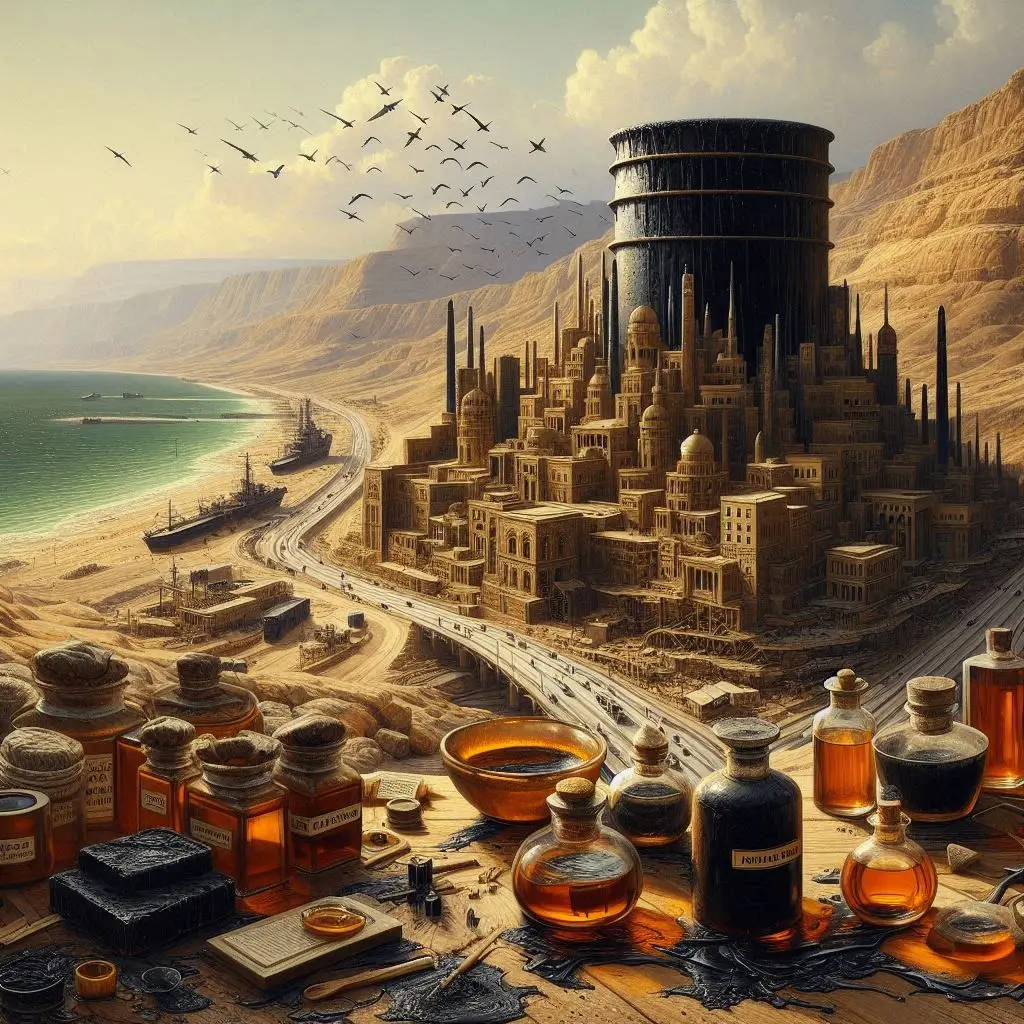
Bitumen of Judea
In this exploration, Bitumen of Judea, I explore the history, uses, chemical makeup, and current relevance of Judean bitumen before offering some thoughts on its lasting influence.
Judean bitumen, often referred to as Syrian asphalt or Jewish pitch, is special in the fields of science, history, and culture. Originating in the Dead Sea area, this material has been used for thousands of years for a variety of applications.
Judean bitumen is evidence of the long-lasting influence of prehistoric materials on human history. Its roots in the Bible and its significant significance in ancient healing and architecture have left an enduring impression. Its chemical characteristics, historical uses, and current importance provide a complex view of the lasting legacy of a substance that has endured the test of time. Looking back at its path from ancient applications to contemporary usage, Judean bitumen continues to be an intriguing link between the past and present.
Origins and Significance in History:
The biblical territory of Judea, which includes portions of present-day Israel and Jordan, is where the phrase "Bitumen of Judea" originates. This thick, tar-like material is mostly extracted from the Dead Sea and has been there for thousands of years. Older historical accounts, such as those written by Pliny the Elder and Josephus, describe the use of bitumen in building, medicine, and mummification.
In ancient buildings, bitumen was essential. The well-known biblical story of the Tower of Babel emphasizes the sticky and water-resistant qualities of bitumen, suggesting its use as mortar. Baturen was used by the ancient Egyptians in their mummification rites to preserve corpses for the afterlife. It was employed in medicine because of its purported therapeutic benefits.
Properties and Chemical Composition:
Judean bitumen is a complex combination of hydrocarbons made up mostly of high-molecular-weight compounds, resins, and asphaltenes. Depending on the source and extraction techniques, its precise composition may change. Its adhesive, waterproof, and lasting qualities are a result of the special arrangement of its parts.
Because of its chemical makeup, bitumen can adhere to a wide range of surfaces and is thus a great material for waterproofing and building projects. Its durability in earlier uses may be attributed to its resistance to external factors like water and temperature changes.
Historical Uses:
Judean bitumen was essential to the development and upkeep of ancient civilizations. In addition to being used in mortar, it protected vessels from the corrosive effects of saltwater by acting as a sealant. It was also used in medicine due to its supposed medicinal qualities, which reflects the long-standing faith in its ability to cure.
Bitumen became more and more common in road building throughout the Roman era. The well-known Roman roads, which are recognized for their sturdiness, often used bitumen as a binder. This application demonstrated how the material may extend the life of buildings that are subjected to weather and high traffic.
Modern Importance:
Although bitumen has been mostly superseded by other building materials in contemporary times, it is still used in some specialized fields. For example, bitumen may be used as part of archaeological conservation efforts to protect historic buildings and artifacts. To prepare it for possible uses in fields like materials science and health, researchers are also investigating its chemical characteristics.
Furthermore, the Bitumen of Judea's historical relevance endures in artistic and cultural settings. Its historical resonance lends a genuine touch to restoration work, and artists and artisans may use it to create traditional paintings.
Issues of the Present and Environmental Reflections:
The availability of substitute resources and environmental considerations make bitumen usage in Judea difficult in the modern day. Bitumen extraction and processing may have negative effects on the environment, such as disturbance of natural habitats and possible damage to aquatic ecosystems in the Dead Sea area. It is becoming more and more important to strike a balance between bitumen's historical value and environmental responsibility as society places a greater emphasis on sustainable methods.
Scientists and environmentalists are investigating strategies to lessen the negative effects of bitumen production on the environment. To guarantee that the use of Judean bitumen complies with contemporary environmental regulations, sustainable extraction techniques are being explored in conjunction with measures to reduce ecological disturbance.
Furthermore, the creation of synthetic alternatives has resulted from the hunt for replacement materials with comparable qualities. The goal of these alternatives is to mimic bitumen's waterproofing and adhesion properties without having negative environmental effects. Consequently, contemporary, environmentally acceptable substitutes pose a threat to the traditional material, making it harder for it to stay in use for a variety of purposes.
Cultural Preservation and Creative Revival: Bitumen of Judea's cultural and creative value endures despite these obstacles. The challenging duty of conserving historic buildings, murals, and relics while maintaining their historical authenticity falls often on conservationists. In some restoration projects, bitumen usage is carefully studied to preserve the ancient materials' integrity.
Because bitumen has been used historically, artists and artisans have been motivated to include it in their creations as a tribute to heritage. The material's distinctive texture and deep, dark hue help to create items that have an old-world look. This artistic renaissance guarantees that Bitumen of Judea's legacy will always have an impact on modern-day artistic undertakings.
Gazing Forward:
Historical materials like the Bitumen of Judea bring to light the difficult balance between innovation and tradition preservation in the rapidly changing field of materials research. The tale of Bitumen of Judea is still developing, connecting the past to the present and inspiring us to look for long-term answers as we negotiate the difficulties that come with using it—from environmental concerns to the creation of substitutes. The voyage of the substance, characterized by adaptability and resilience, challenges us to investigate the relationship between science, culture, and history in our continuing pursuit of sustainable development.

